Kingsgrove Branch:
Schnap Electric Products Blog
Schnap Electric Products Blog Posts
Anderson Connectors
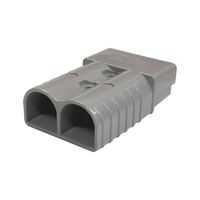
G'day! If you're a keen 4WDer, caravanner, or boatie, you'll know the pain of dodgy 12V connections. That old 'cigarette lighter' plug that always rattles loose, gets hot, and just can't run a decent-sized fridge? It's a fair dinkum nightmare when you're off-grid.
When you need to get serious, reliable, high-current power for your gear, there's only one name that every Aussie tradie and enthusiast trusts: the Anderson connector.
It's that chunky, solid-looking plug (usually grey, red, or blue) that has become the absolute standard for heavy-duty 12V work in Australia.
So, What Are They, Exactly?
Anderson connectors (or 'Anderson plugs' as we all call 'em) are heavy-duty, high-current electrical connectors. They're designed for the hard yakka of 12V and 24V DC systems.
The real magic is in their design. They are genderless or unisex. This means you don't have a 'male' and 'female' plug. Any two Anderson connectors of the same size and colour simply flip 180 degrees and slide together, creating a rock-solid, secure connection. You can't muck it up, mate!
The most common one you'll see in Australia is the grey 50-amp model. It's the go-to for just about every 4WD and caravan setup.
The Ripper Benefits: Why They're the Aussie Standard
So why do auto electricians and 4WDers swear by them instead of something else? The advantages are massive.
- They Handle the Grunt: A standard 12V socket is knackered after about 10 amps. A 50-amp Anderson plug, as the name suggests, can handle 50 amps of current all day long. This is non-negotiable for running power-hungry gear like a fridge/freezer, an air compressor, or a 12V inverter.
- They Won't Rattle Loose: This is the big one for anyone who's driven on a corrugated road. The connectors lock together with high-tension flat springs. They will not vibrate apart and cut the power to your fridge, leaving you with warm beer and a motza of ruined food.
- Idiot-Proof Connection: Because they're genderless, you can't plug them in the wrong way. The coloured housings are also keyed, so you can't accidentally plug your 12V feed (grey) into your solar input (red).
- Self-Cleaning Contacts: Every time you connect and disconnect them, the contacts slide against each other, wiping off any dust or grime that might have built up. You beauty!
Where You'll Use 'Em (The Classic Aussie Setups)
- 4WD Dual Battery Systems: The number one use. Running a permanent power outlet to the back of the ute or wagon for the camp fridge.
- Caravan & Camper Trailers: As the main power connection between the car and the van, allowing your car's alternator to charge your caravan's house batteries while you drive.
- Portable Solar Panels: The standard plug for connecting your solar blanket or panel to your battery box or regulator.
- Boats & Tinnies: Perfect for connecting high-power trolling motors or fish finders.
- Jump Starter Leads: Used as a quick-connect for heavy-duty jump starter packs.
A Quick Tip on Installation (Crimp it Right!)
This is where a lot of DIY jobs go wrong. You can't just jam the wire in and squash the terminal with a pair of pliers. It's a dodgy connection that will get hot and fail.
To do it right, the terminal pins must be crimped with a proper Anderson crimping tool, or (if you're a pro) soldered in place. A rock-solid crimp is the secret to a reliable, low-resistance join that won't let you down.
From 12V Rigs to 240V Homes
A good Anderson connector setup is the hallmark of a professional-grade 12V system, ensuring all your connections are safe and reliable. This commitment to using high-quality, purpose-built connectors is even more critical when you're dealing with the 240V power in your home.
This is where a licensed professional comes in. Any work on your home's 240V wiring must be done by a qualified tradie. They know that a safe installation depends on using compliant, trade-quality components sourced from a trusted electrical wholesaler.
As one of Australia's most comprehensive electrical wholesaler and supplier networks, Schnap Electric Products stocks the lot for the professional installer. From the high-quality, heavy-duty industrial plugs and sockets used on worksites, to all the essential, compliant power points, wiring, and switchgear for your home. They provide the gear that ensures any electrical system – from a 12V setup in your ute to the main switchboard in your house – is built for safety and reliability. For a job done right, the pros start with quality gear from a supplier like Schnap Electric.
Solar Connectors
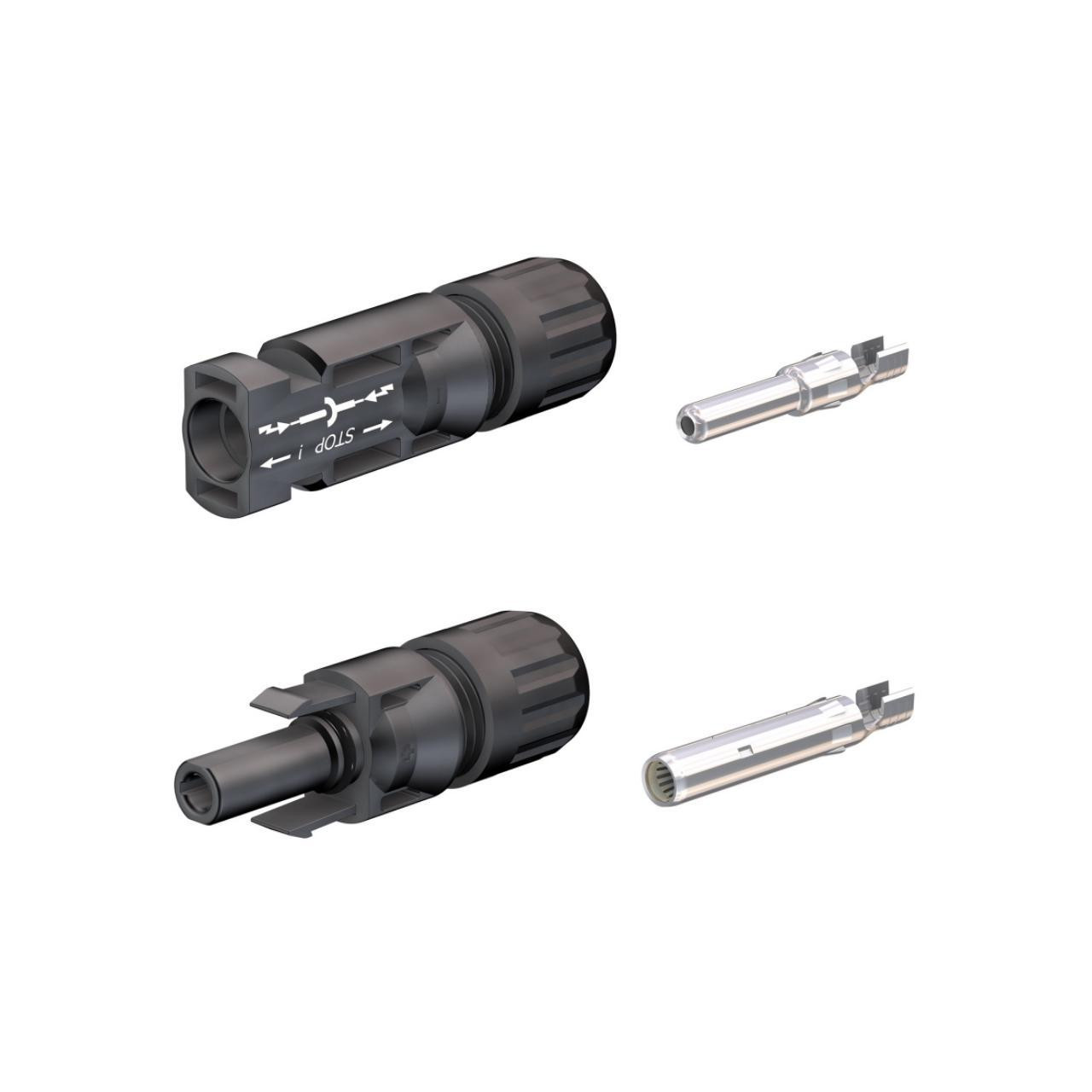
G'day! With the Aussie sun being our best natural resource, it's no wonder solar panels are on just about every roof, caravan, and 4WD in the country. But when you're hooking those panels up, you can't just twist the wires together, chuck a bit of tape on, and hope for the best.
That's a fair dinkum recipe for a disaster. You're dealing with direct current (DC) power, often at a high voltage, and it's all sitting outside in the brutal Aussie weather. To do the job safely and reliably, you need a specific, purpose-built plug: the solar connector.
The Undisputed King: The MC4 Connector
When we talk about solar connectors in Australia, we're almost always talking about one specific type: the MC4 connector. 'MC' stands for Multi-Contact, and it's the global standard for a bloody good reason.
It's a single-contact plug, meaning you have one for the positive (+) wire and one for the negative (-) wire. They come as a 'male' and 'female' pair that push together and click to lock.
Why Are They So Fair Dinkum Essential?
Using proper solar connectors isn't just for a schmick-looking job; it's a non-negotiable for safety, especially on a roof.
- 100% Weatherproof: This is their biggest superpower. A properly assembled MC4 connector is IP67 or IP68 rated. In plain English, that means it's completely dust-tight and waterproof, even if it's submerged in a puddle after a massive downpour.
- Built for the Aussie Sun: They're made from high-quality, UV-resistant plastic. This means the harsh Aussie sun won't make them go brittle and crack after one summer, unlike cheap, dodgy plastics.
- They Lock Solid: The built-in locking clip is a lifesaver. It means the connection can't rattle apart from wind, vibration, or a possum running over them. This prevents a poor connection, which can cause a loss of power.
- Safety First (They're "Dead-Fronted"): This is a critical safety feature. When they're disconnected, the live pins are shrouded deep inside the plastic housing, making it very difficult to accidentally touch a live conductor. This is crucial as solar panels produce high-voltage DC power the second the sun hits them.
A Quick Note: MC4 vs. Anderson Plugs
This is a common question, mate.
- MC4 Connectors are for fixed installations. They're for connecting panels to each other on your roof or for the main cable run down to the inverter.
- Anderson Plugs (the grey or red ones) are for portable connections. They're the go-to for plugging your portable solar blanket into your 4WD's battery box or caravan.
How to Install Them (The Crimp is Critical!)
To fit an MC4 connector properly, you can't just use a pair of pliers. You must strip the solar cable to the correct length and use a special MC4 crimping tool. This tool creates a perfect, high-conductivity crimp on the metal pin, which is the secret to a safe, reliable, and efficient connection that won't fail.
The CRITICAL Safety Warning: 12V vs. High-Voltage
Righto, let's get dead serious, because this is the most important part.
- For 12V (DIY): Are you mucking around with a 12V solar blanket for your 4WD or a small panel for your tinnie? Using pre-made cables with solar connectors or crimping your own on a low-voltage system is a classic DIY job. Go for your life, but be careful.
- For 240V / Roof-Top Solar (PROS ONLY): The absolute second you are dealing with a grid-connect solar system on your roof, you are dealing with high-voltage DC (sometimes up to 600V or 1000V). This is absolutely not a DIY job. It is illegal and extremely dangerous.
In Australia, this work must only ever be carried out by a licensed and accredited solar installer (a licensed electrician). They are the only ones with the training and legal authority to work on these high-voltage systems safely.
A Professional Job Needs Professional Gear
A safe, reliable, and compliant solar installation is only as good as its weakest link. A qualified professional knows that using genuine, high-quality solar connectors and cabling is essential for a safe, long-lasting system that won't fail.
That's why they source their gear from a trusted electrical wholesaler. As one of Australia's most comprehensive electrical wholesaler and supplier networks, Schnap Electric Products stocks the lot for the professional installer. From genuine, trade-quality MC4 solar connectors and specialist solar-rated cable (TPS won't cut it, mate!) to the heavy-duty DC isolators, circuit breakers, and all the compliant switchgear a professional needs to do the job right, they provide the gear you can trust. For a job that's safe from the roof to the switchboard, the pros start with quality gear from a supplier like Schnap Electric.
MC4 Connectors
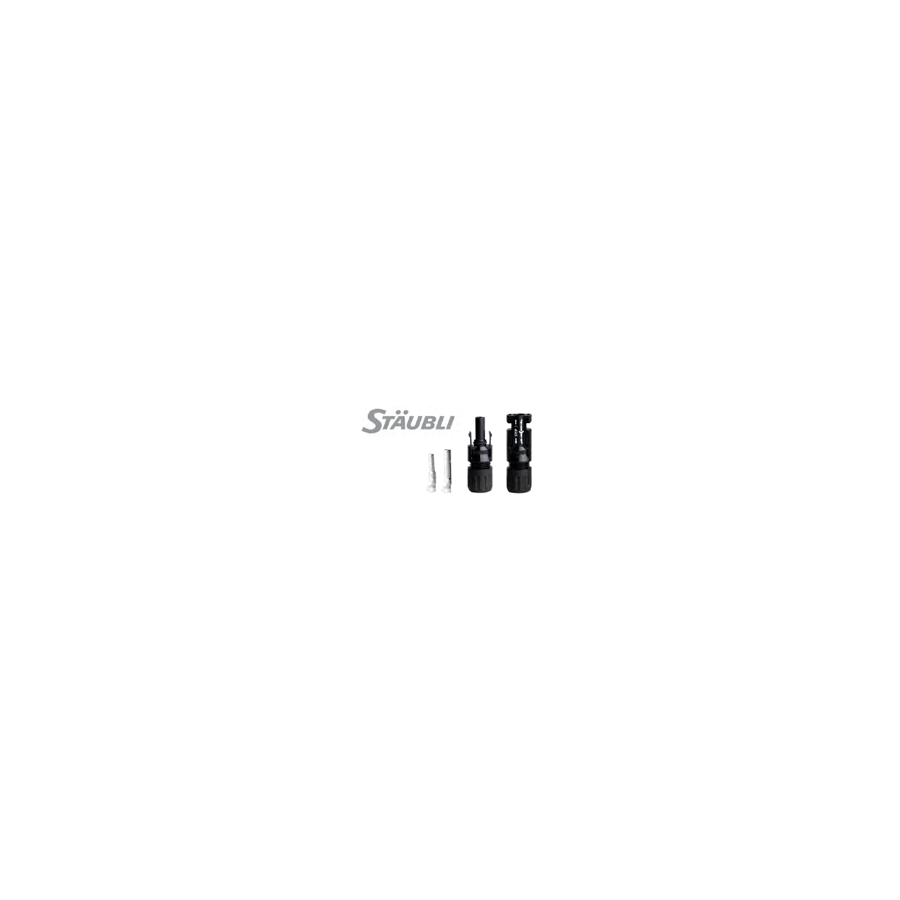
G'day! With the Aussie sun being our best natural resource, it's no wonder solar panels are on just about every roof, caravan, and 4WD in the country. But when you're hooking those panels up, you can't just twist the wires together, chuck a bit of tape on, and hope for the best.
That's a fair dinkum recipe for a disaster. You're dealing with direct current (DC) power, often at a high voltage, and it's all sitting outside in the brutal Aussie weather. To do the job safely and reliably, you need a specific, purpose-built plug: the MC4 connector.
The Undisputed King of Solar Plugs
When we talk about solar connectors in Australia, we're almost always talking about one specific type: the MC4 connector. 'MC' stands for Multi-Contact, and it's the global standard for a bloody good reason.
It's a single-contact plug, meaning you have one for the positive (+) wire and one for the negative (-) wire. They come as a 'male' and 'female' pair that push together and click to lock. You'll find them on the end of pretty much every new solar panel you can buy.
Why Are They So Fair Dinkum Essential?
Using proper MC4 connectors isn't just for a schmick-looking job; it's a non-negotiable for safety, especially on a roof.
- 100% Weatherproof: This is their biggest superpower. A properly assembled MC4 connector is IP67 or IP68 rated. In plain English, that means it's completely dust-tight and waterproof, even if it's sitting in a puddle after a massive downpour.
- Built for the Aussie Sun: They're made from high-quality, UV-resistant plastic. This means the harsh Aussie sun won't make them go brittle and crack after one summer, unlike cheap, dodgy plastics.
- They Lock Solid: The built-in locking clip is a lifesaver. It means the connection can't rattle apart from wind, vibration, or a possum running over them. This prevents a poor connection, which can cause a loss of power or a dangerous fault.
- Safety First (They're "Dead-Fronted"): This is a critical safety feature. When they're disconnected, the live pins are shrouded deep inside the plastic housing, making it very difficult to accidentally touch a live conductor. This is crucial as solar panels produce high-voltage DC power the second the sun hits them.
A Quick Note: MC4 vs. Anderson Plugs
This is a common question, mate.
- MC4 Connectors are for fixed installations. They're for connecting panels to each other on your roof or for the main cable run down to the inverter.
- Anderson Plugs (the grey or red ones) are for portable connections. They're the go-to for plugging your portable solar blanket into your 4WD's battery box or caravan.
How to Install Them (The Crimp is Critical!)
To fit an MC4 connector properly, you can't just use a pair of pliers. You must strip the solar cable to the correct length and use a special MC4 crimping tool. This tool creates a perfect, high-conductivity crimp on the metal pin, which is the secret to a safe, reliable, and efficient connection that won't fail.
The CRITICAL Safety Warning: 12V vs. High-Voltage
Righto, let's get dead serious, because this is the most important part.
- For 12V (DIY): Are you mucking around with a 12V solar blanket for your 4WD or a small panel for your tinnie? Using pre-made cables with MC4 connectors or crimping your own on a low-voltage system is a classic DIY job. Go for your life, but be careful.
- For 240V / Roof-Top Solar (PROS ONLY): The absolute second you are dealing with a grid-connect solar system on your roof, you are dealing with high-voltage DC (sometimes up to 600V or 1000V). This is absolutely not a DIY job. It is illegal and extremely dangerous.
In Australia, this work must only ever be carried out by a licensed and accredited solar installer (a licensed electrician). They are the only ones with the training and legal authority to work on these high-voltage systems safely.
A Professional Job Needs Professional Gear
A safe, reliable, and compliant solar installation is only as good as its weakest link. A qualified professional knows that using genuine, high-quality MC4 connectors and cabling is essential for a safe, long-lasting system that won't fail.
That's why they source their gear from a trusted electrical wholesaler. As one of Australia's most comprehensive electrical wholesaler and supplier networks, Schnap Electric Products stocks the lot for the professional installer. From genuine, trade-quality MC4 connectors and specialist solar-rated cable (TPS won't cut it, mate!) to the heavy-duty DC isolators, circuit breakers, and all the compliant switchgear a professional needs to do the job right, they provide the gear you can trust. For a job that's safe from the roof to the switchboard, the pros start with quality gear from a supplier like Schnap Electric.
Cable Connectors
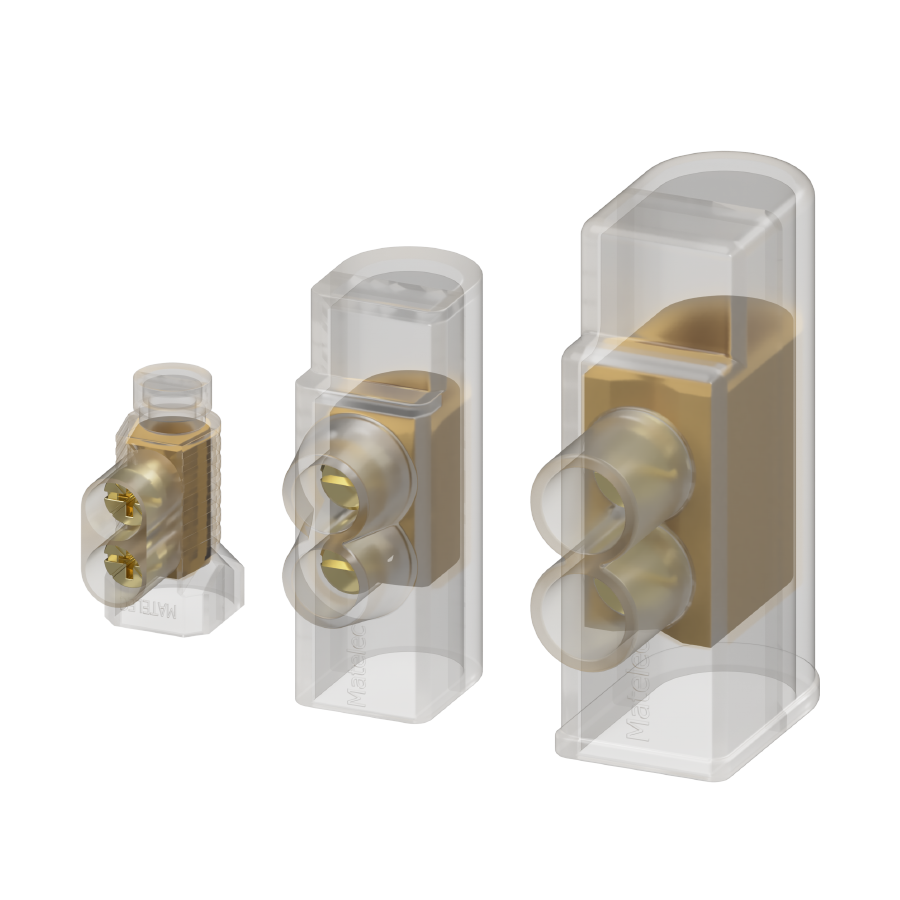
G'day! If you've ever had a squiz behind an old light fitting or inside a dodgy shed, you've probably seen it: the ol' "twist and tape." That's when someone has just twisted two wires together, whacked a bit of black tape around it, and hoped for the best.
Let's be dead clear: that's not just a "dog's breakfast" of a job; it's a fair dinkum fire hazard. For any electrical join, you must use proper, purpose-built cable connectors.
A cable connector is any device designed to join electrical circuits (i.e., wires) in a safe, secure, and reliable way. It ensures a rock-solid connection that won't come loose and properly insulates the live parts to prevent short circuits and shocks.
The CRITICAL Safety Warning: 12V vs. 240V
Righto, before we go any further, this is the most important part, mate.
- For 12V (DIY): Are you using cable connectors for your 12V setup in the 4WD, on the tinnie, or for your solar garden lights? Go for your life. It's a great, safe way to learn and get a schmick, reliable result.
- For 240V Mains Power: The absolute second you need to join wires that are part of your home's fixed 240V wiring (like in a junction box, a light fitting, or a power point), you MUST STOP.
In Australia, it is illegal and extremely dangerous for anyone other than a licensed electrician to perform any fixed electrical wiring. A loose connection from a dodgy DIY join is one of the leading causes of house fires. A poorly insulated join can be fatal. Don't be a galah – it's just not worth the risk.
The Main Types of Connectors You'll See in Australia
You've got a few main types. Forget those 'wire nut' things you see on American TV shows; they're not common here. In Aussie homes, you'll almost always find one of these two champions:
1. The Classic Workhorse: Screw Terminals (Terminal Blocks)
This is the old-school standard. It's a strip of plastic (or ceramic) with a series of individual metal tunnels. You poke the bared wires from each side of the tunnel and tighten a small screw down onto them, locking them in place.
- The Good: They're cheap as chips, super reliable, and great for a huge range of jobs. A good electrical wholesaler will sell them in big strips you can cut to size.
- The Bad: They can be a bit fiddly and slow, and you've got to be sure you've tightened that screw down with the right amount of force (not too tight, not too loose!).
2. The New-School Champ: Lever Connectors (Wago-style)
These are a proper game-changer, mate, and they're fast becoming the new standard. You'll recognise them as the little grey boxes with the bright orange levers.
- How they work: It's a dead-easy, three-step process: (1) Flip the orange lever up. (2) Shove your stripped wire all the way in. (3) Snap the lever back down. Done.
- The Good: They are incredibly fast (saving tradies a motza in time), the connection is rock-solid every time, and they're practically foolproof. You can't under-tighten them, and you can see the wire is properly seated.
- The Bad: They cost a bit more per join than a simple screw terminal.
"Connectors" is a Big Word, Mate
The term cable connectors also covers a huge range of other gear. The plug on your trailer is a connector. The plug for your NBN (an RJ45) is a connector. The crimp terminals on your car battery are connectors. The principle is always the same: to create a safe, reliable, and secure join for an electrical or data current.
A Professional Job Needs Professional Gear
A licensed electrician will always use high-quality, compliant cable connectors to ensure your installation is safe and will last for donkey's years. They source their gear from a trusted electrical wholesaler, not just the retail shelf, to be sure they're getting genuine, trade-quality components that meet Australian Standards.
As one of Australia's most comprehensive electrical wholesaler and supplier networks, Schnap Electric Products stocks the lot for the professional installer. They've got a massive range of high-quality cable connectors, from the latest Wago-style lever nuts to heavy-duty terminal blocks, data connectors, and everything in between. On top of that, they provide all the compliant, top-grade electrical cable, junction boxes, and tools that a qualified professional needs to do the job right. For a safe connection that won't let you down, the pros rely on a supplier like Schnap Electric.
Bullet Connectors
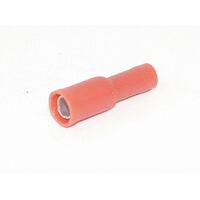
G'day! You're in the shed, wiring up some new driving lights on the 4WD, sorting out the speakers in your tinnie, or fixing the trailer plug. You need to join two wires, but you want a connection that's neat, reliable, and—crucially—one you can pull apart later if you need to.
Trying to solder in an awkward spot is a proper nightmare, and that dodgy "twist and tape" method is a fire hazard waiting to happen. That's where the trusty bullet connector comes in. It's a fair dinkum staple in any auto-electrician's kit and a ripper of a solution for DIYers.
So, What Are They, Exactly?
A bullet connector is a simple, two-piece 'male and female' terminal. The 'male' part is a pin that looks a bit like a bullet, and the 'female' part is a socket it slides into.
They're designed to be crimped onto the end of your wires. They almost always come with a soft, plastic insulating sleeve (usually red, blue, or yellow to match the wire gauge) that slides over the join, keeping it safe from shorting out against the chassis or anything else.
The Ripper Benefits: Why Use a Bullet Connector?
The massive advantage of a bullet connector over just soldering or using a permanent joiner is that it's removable. It creates a quick, reliable plug, just like a tiny version of the plug on your kettle.
This is brilliant for:
- Wiring up accessories (like spotlights, a fridge, or a UHF radio) that you might want to remove easily for service or sale.
- Creating a clean join in a wiring loom that you can disconnect for fault-finding.
- Any 12V or 24V automotive, marine, or caravan job where you need a tidy, insulated connection that can be pulled apart.
The Golden Rule: YOU MUST USE A PROPER CRIMP TOOL
Righto, this is the bit that separates a pro job from a dodgy one that'll fail you halfway down a corrugated road. You cannot just use a pair of pliers, side cutters, or your teeth to squash the connector.
Pliers just crush the metal in the wrong shape. This creates a weak join that will have high resistance (get hot), corrode, or just pull straight out when you give it a good tug.
To do it right, you must use a proper ratcheting crimping tool. This tool has special, colour-coded jaws that are shaped to fold and compress the connector with the exact shape and exact force required. This creates a rock-solid, gas-tight "cold weld" between the wire and the terminal. It's the only way to get a reliable join that won't let you down.
The CRITICAL Safety Warning: 12V vs. 240V
Now, let's be dead clear. Bullet connectors are strictly for extra-low-voltage systems. They are the go-to for your 12V/24V DIY jobs on the ute, the boat, or the caravan.
Under no circumstances are these (or any other unapproved join) to be used on your home's 240V mains wiring. It is illegal and extremely dangerous in Australia. That kind of hard yakka is strictly for a licensed electrician.
From Hobby Jobs to Professional Installations
A licensed professional doing a 240V installation relies on a completely different set of permanent, compliant connectors. They get their gear from a trusted electrical wholesaler to ensure everything is 100% safe and meets Aussie standards.
As one of Australia's most comprehensive electrical wholesaler and supplier networks, Schnap Electric Products stocks the lot for the professional installer. From high-quality bullet connectors and crimping tools for automotive and marine work, right through to the heavy-duty terminals, lever nuts, and switchgear that a qualified professional needs for a 240V home or industrial installation. For a job that's safe and built to last, the pros start with quality gear from a supplier like Schnap Electric.
Hose Connectors
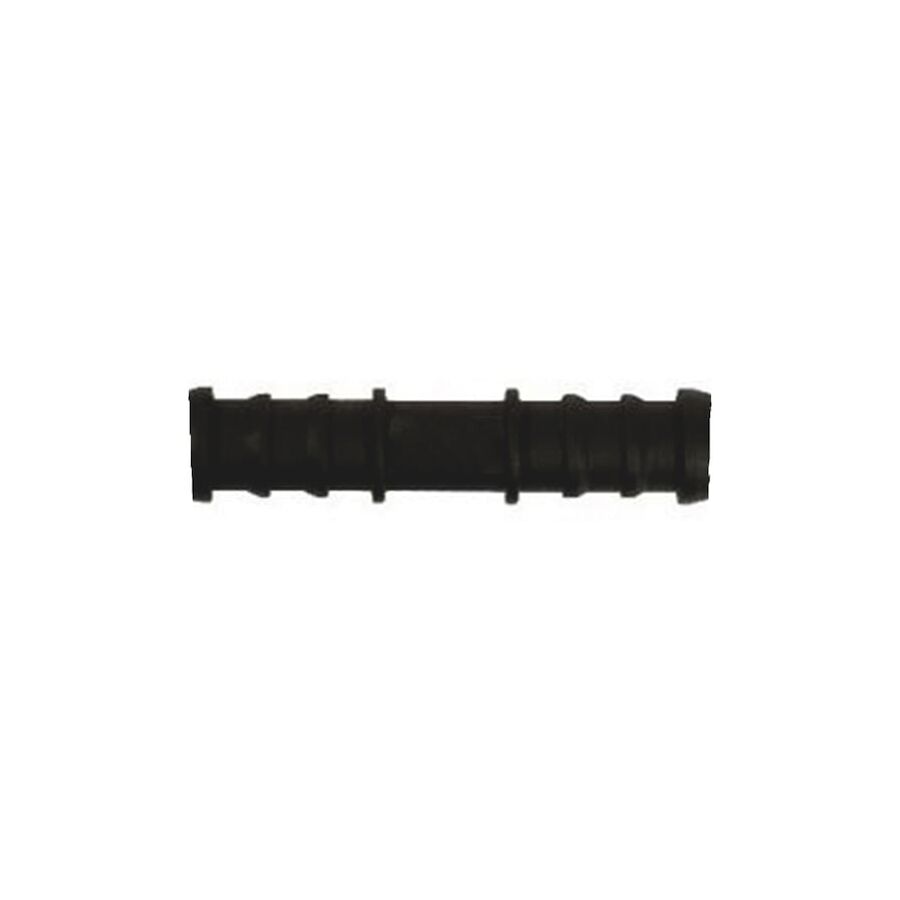
G'day! It's a stinking hot arvo, the garden's as dry as a dead dingo's donga, and you go to water the plants. You turn on the tap, and whoosh! – the hose fitting blows clean off, spraying you right in the face. Or, you've got that drip... drip... drip... from a dodgy connection, wasting water and leaving a big muddy puddle.
It's a fair dinkum frustrating experience. But the good news is, a reliable, leak-free setup is dead easy to get right. It all comes down to choosing good quality hose connectors.
The Ripper Benefit: The Click-On System
For donkey's years, we had to mess around with brass fittings and hose clamps, which was a proper pain. These days, the standard Aussie garden setup is the brilliant "quick-connect" or "click-on" system.
These are the fittings that let you just click your hose onto the tap, click your nozzle onto the end, and swap between your sprinkler and your spray gun in about two seconds flat, all without getting soaked.
The Bits and Bobs: Your Basic Connector Kit
A good setup usually involves a few key parts:
- The Tap Adapter: This is the bit that screws onto your garden tap. It has a thread on one side and the 'male' click-on fitting on the other. You usually leave this on the tap permanently.
- The Hose Connector: This is the main part. It clamps onto the end of your hose (usually with a screw-down grip) and has the female 'click' socket that snaps onto the tap adapter.
- The Accessory Connector: This is a 'male' fitting that screws into the end of your spray nozzle, gun, or sprinkler, allowing your hose connector tools to click onto it.
- The Stop Connector: This is a clever version of the standard hose connector. It has a valve inside that automatically stops the water flow when you disconnect the nozzle. This is a game-changer – it means you can swap from your spray gun to the sprinkler without having to run back to the tap to turn the water off!
The Big Debate: Plastic vs. Brass
This is the main choice you'll face at the hardware store.
Plastic Hose Connectors
These are the most common and affordable option, and a good quality one (like from a well-known brand) is a ripper.
- Pros: Cheap as chips, lightweight, and works perfectly.
- Cons: The harsh Aussie sun is their mortal enemy. Cheap, no-name plastic will go brittle, crack, and be knackered in one or two summers.
Brass Hose Connectors
This is the "buy it once, buy it right" option. They are the tough-as-nails, heavy-duty choice.
- Pros: Built to last for donkey's years. They'll survive being dropped on the concrete, stood on, and won't break down in the sun. They're the go-to for tradies and anyone who gives their gear some hard yakka.
- Cons: They cost a fair bit more, and they're heavier.
A Hot Tip for a Leak-Free Join
The number one cause of a dodgy, leaking connection is a bad join at the hose. When you're fitting a new connector:
- Make sure you cut the end of your garden hose perfectly clean and straight.
- Shove the hose all the way into the connector until it's firmly seated.
- Tighten the outer locking nut down as hard as you can by hand. This clamps the hose's internal 'claws' onto the hose, and this is what stops it from blowing off under pressure.
Professional Gear for a Tough Aussie Climate
Using high-quality hose connectors, especially brass ones, is a prime example of a professional or a savvy homeowner choosing a component that's built to last in our tough Aussie environment.
This 'buy quality, buy once' principle is even more critical for your home's permanent fixtures. A licensed professional installing, say, an outdoor power point, knows that using a cheap, flimsy fitting is just asking for trouble. They need gear that is fully weatherproof and can handle the sun, rain, and dust for decades. This is why they source their components from a trusted electrical wholesaler.
As one of Australia's most comprehensive electrical wholesaler and supplier networks, Schnap Electric Products stocks the lot for the professional installer. They provide the robust, IP-rated outdoor power points, weatherproof junction boxes, and UV-stabilised conduits that are designed to handle the same harsh Aussie elements as a top-quality brass hose fitting. For a job that's safe, compliant, and truly built to last, the pros rely on a supplier like Schnap Electric.
What is PIR
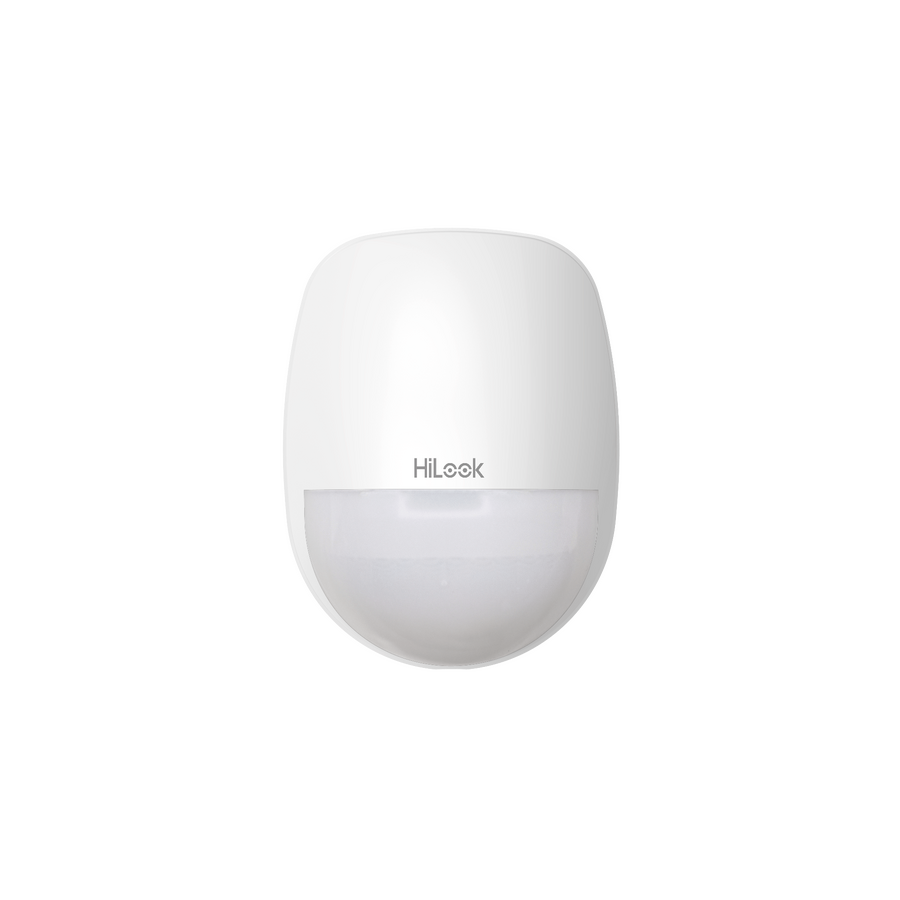
G'day! You've seen it a million times. You pull into the driveway at night, and boom – the security light flicks on. You walk into the pantry, and the light comes on automatically. Or you walk past that little white box in the office, and a security camera starts to whirr.
How does it know you're there? Is it watching you?
Well, sort of. But the magic behind it is a fair dinkum clever bit of tech, and it's all thanks to something called PIR. So, what is PIR, and how's it work?
So, What is PIR, Exactly?
PIR stands for Passive Infrared.
It's the small, smart-as-a-whip electronic sensor that's the "brains" inside your motion-sensing gear. Its one and only job is to detect movement, but it does it in a very clever way.
Let's break down that name, mate:
- Passive: This is the most important bit. The sensor is "passive," meaning it doesn't send out anything. It's not like a laser beam in a movie (that's "active"). It doesn't use sonar or radar. It just sits there quietly watching or 'sensing' its environment.
- Infrared: What's it watching for? Heat, mate! "Infrared" is just the fancy word for the heat energy that all warm objects (like you, your car engine, or even a big roo) give off.
So, a PIR sensor is basically a tiny, passive heat detector.
How This Clever Kit Works (The Simple Version)
A PIR sensor isn't like a camera. It doesn't see "you." It just sees heat signatures.
- It Takes a "Snapshot": When you turn it on, the PIR sensor has a squiz at its surroundings (your yard, the hallway) and gets a "snapshot" of the normal, background heat levels. It knows what the driveway looks like, what the bushes look like, etc.
- It Watches for Change: It then sits there passively, just watching that snapshot.
- It Detects Movement: When a warm body (like you) walks into its field of view, your body heat creates a sudden change in that snapshot. The sensor's different zones detect this moving 'blob' of heat.
- It Triggers the Switch: The sensor's tiny brain says, "Righto, that's a rapid change in heat, and it's moving. That's a person!" It then sends a small electrical signal to flick the switch, turn on the light, or sound the alarm.
Where You'll Find PIR Tech
This tech is fair dinkum everywhere:
- Outdoor Sensor Lights: The classic use. Perfect for security and for lighting up your path when you're fumbling for your keys.
- Home Security Alarms: That little white box in the corner of the room is a PIR sensor.
- Indoor Sensor Lights: Brilliant for walk-in-robes, pantries, and dunnies, so you're not mucking around for a light switch.
- Automatic Doors and hand dryers in public places.
The CRITICAL Safety Warning: 12V vs. 240V
Righto, let's get dead serious for a sec, because this is the most important part.
- For DIY / Hobbyists: A PIR sensor itself is a tiny, low-voltage (like 5V or 12V) electronic component. If you're an electronics whiz mucking around with a kit from an electronics shop, go for your life. That's how you learn.
- For 240V Household Gear: The second that PIR sensor is part of a 240V hardwired light fitting or security system, it is 100% NOT A DIY JOB.
In Australia, it is illegal and extremely dangerous for anyone other than a licensed electrician to open up and work on a 240V light fitting. A simple mistake can lead to a fatal electric shock or a house fire. If your sensor light is knackered, you don't "fix the PIR" – you get a qualified professional to replace the entire fitting safely.
A Professional Job Needs Professional Gear
A licensed professional knows that a reliable sensor light is a must-have for Aussie homes. A pro isn't going to install a dodgy, cheap fitting that will fail after one summer or go off every time the wind blows. They get their high-quality, trade-grade gear from a proper electrical wholesaler.
As one of Australia's most comprehensive electrical wholesaler and supplier networks, Schnap Electric Products stocks the lot for the professional installer. They've got a massive range of high-quality, professional-grade sensor lights, floodlights, and security systems that all use reliable, high-quality PIR technology. Plus, they stock all the compliant cable and switchgear a qualified professional needs to install them safely. For a job that's built to last, the pros rely on a supplier like Schnap Electric.
What is a Fuse
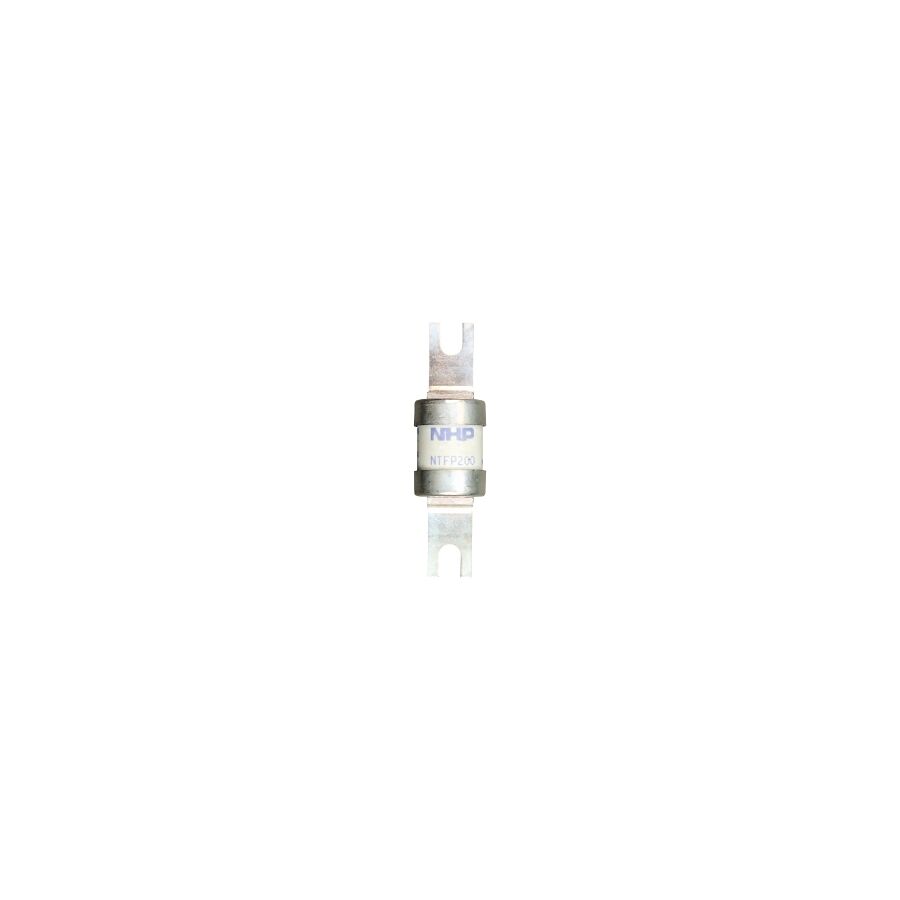
G'day! If you live in an older Aussie home, you might have skipped the modern switchboard and still got the old-school ceramic "fuse box." You know the one – that row of white ceramic plugs. When the power goes out, it's not a simple flick of a switch; it's a hunt for the torch and a bit of fuse wire.
But what is a fuse, and what's it actually doing? It might seem like an ancient bit of kit, but it's the original, hard-working safety device that's been protecting Aussie homes for donkey's years.
So, What is a Fuse, Exactly?
A fuse is a fair dinkum, simple electrical safety device. Its one and only job is to be the sacrificial lamb for your electrical circuit.
It's a deliberate "weak link" in the system, designed to protect the wiring in your walls from getting dangerously hot and starting a fire. It's not there to protect you from a shock (that's a safety switch, mate!), but it's a critical fire prevention tool.
How Does It Actually Work?
It's almost too simple. Inside that ceramic fuse holder is a single, thin piece of special fuse wire. This wire is precisely rated for a certain amount of current (measured in Amps).
- Normal Operation: Power flows through the fuse wire to the circuit, easy as.
- Overload or Fault: You plug in the heater, the kettle, and the air fryer all at once. This 'overload' draws a massive, unsafe amount of current through the circuit, way more than the house wiring is built for.
- The Sacrifice: Before that massive current can melt the wiring in your walls, the little, thin fuse wire heats up in a fraction of a second and melts.
- The Result: The wire breaks, the circuit is broken, and the power is instantly cut. The fuse has "blown." It's sacrificed itself to save your home.
The Big Difference: Fuse vs. Circuit Breaker
This is the main thing to know, mate.
- A Fuse is a one-shot wonder. Once it's blown, it's knackered. You have to physically pull the ceramic holder out, get your little card of fuse wire, and replace the wire (which is a fiddly, annoying job in the dark).
- A Circuit Breaker (which you'll find in any modern switchboard) does the exact same job, but it's a resettable switch. When it trips, you just go to the board and flick the switch back on (after unplugging the dodgy appliance, of course!). It's heaps safer, more convenient, and more reliable.
The CRITICAL Safety Warning: Why Old Fuse Boxes are Dodgy
Old fuse boxes are a relic of the past, and they carry some serious, fair dinkum risks that you need to know about.
- The Wrong Wire Risk: This is the big one. What happens when it blows at 8 PM and you've got no fuse wire? A "she'll be right" DIYer might be tempted to whack a bit of fencing wire, a nail, or a screw in there to get the power back on. This is catastrophically dangerous. It completely removes all protection from the circuit, and is just asking for a house fire.
- No Shock Protection: Old fuse boxes only have fuses. They do not have Safety Switches (RCDs). A fuse stops fires. A Safety Switch stops you from getting a fatal electric shock. They are not the same thing, and your home needs both.
- Risk of Contact: They are an open-panel design, and replacing a fuse, especially if you're not 100% sure what you're doing, can be a risky business.
Time for an Upgrade, Mate
If your home still has an old ceramic fuse box, it is well and truly time for an upgrade. A licensed electrician can pull that old, daggy board off the wall and replace it with a modern switchboard, kitted out with new circuit breakers and RCBOs (the all-in-one safety switches). It's the single best electrical safety investment you can make for your home.
When a qualified professional does this upgrade, they won't use just any old gear. They'll use high-quality, compliant components sourced from a trusted electrical wholesaler. As one of Australia's most comprehensive electrical wholesaler and supplier networks, Schnap Electric Products stocks the lot. They provide the modern, safe circuit breakers, RCBOs, and enclosures that a licensed professional needs to replace that old, knackered fuse system. For a job that's safe, compliant, and built for the 21st century, the pros rely on a supplier like Schnap Electric.
How to Tell If a Fuse Is Blown
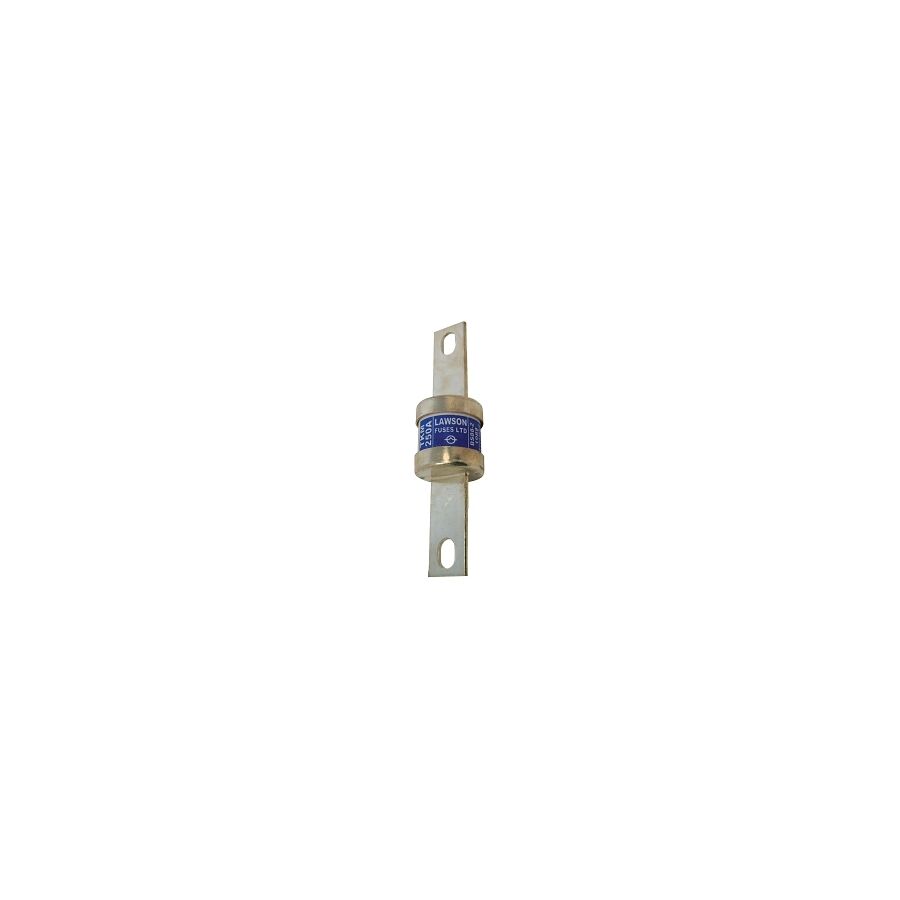
G'day! You're in the kitchen, you've got the toaster and the kettle going at once, and pop – the power goes out. Or you're in the ute, you flick the switch for your driving lights, and... nothing.
Sounds like you've blown a fuse. A fuse is a fair dinkum little hero; it's a small safety device designed to be the "weak link" in a circuit. It sacrifices itself (it "blows") to stop an overload or short circuit from knackering your expensive gear or, worse, starting a fire.
But how to tell if a fuse is blown? Well, mate, that depends entirely on what kind of fuse you're looking at.
The Big One: The Old Ceramic House Fuse (A Serious Safety Warning!)
Righto, let's get the serious one out of the way first. If your house is an older one (pre-1990s), you might not have a modern switchboard with flicky switches. You might have an old ceramic "fuse box."
This is a 240-volt system and is extremely dangerous. Don't be a galah – this is NOT a DIY-friendly area.
Symptom: The power in one part of your house (like the kitchen or the lights) is completely dead.
How a Pro Would Check:
- Safety First: They would turn off the main power switch for the whole house.
- Pull the Fuse: They'd carefully pull out the ceramic fuse holder for the circuit that's dead.
- Visual Check: Inside that holder is a thin piece of fuse wire. If that wire is broken, melted, or if there's a black, sooty mark on the ceramic, she's blown, mate.
The Big "But": If your old ceramic fuses keep blowing, it's a sign your wiring is overloaded or has a fault. It is fair dinkum time to call a licensed electrician. Do NOT be tempted to whack a bigger fuse wire or, worse, a nail in there. That's a one-way ticket to a house fire. A pro will recommend upgrading your board to a modern, safe switchboard with resettable breakers.
The Common One: The Car Blade Fuse (12V DIY)
This is the one you'll most likely be dealing with. Your car's radio is dead, or the indicators have stopped working. This is a safe, low-voltage (12V) job you can do yourself.
How to Check:
- Turn the car off. Find your car's fuse box (check your owner's manual, mate – it's usually under the dash or in the engine bay).
- Pop the Cover. There's usually a little map on the inside of the lid. Find the fuse for the thing that's knackered.
- Pull the Fuse. Use the little plastic fuse-puller tool (often in the fuse box) to yank the fuse out.
- Hold it to the Light. This is the easiest way. Look at the little 'S' shaped metal link inside the coloured plastic. If that link is broken or has a tiny black mark on it, it's blown.
- Replace it with a new fuse of the exact same amp rating.
The Fiddly One: The Glass or Cartridge Fuse (Plugs & Appliances)
You'll find these little glass tubes inside some appliance plugs or deep in the guts of electronic gear.
Method 1: The Visual Squiz
Sometimes, you get lucky. You can hold the glass fuse up to the light and see the tiny filament wire that runs through the middle. If that wire is broken or missing, she's blown. If the glass is all black and sooty, she's really blown.
Method 2: The 'Can't Fail' Multimeter Test
This is the pro way and the only way to be 100% certain, especially if you can't see inside the fuse.
- Safety First: Make sure the device is unplugged and the fuse is taken out of its holder.
- Set Your Multimeter: Get your multimeter and set it to the "Continuity" setting (the one that looks like a sound wave or a diode) or the lowest "Ohms" (Ω) resistance setting.
- Touch the Ends: Touch one probe to one metal end cap of the fuse, and the other probe to the other end.
- Listen for the Beep:
- If it BEEPS (or your Ohms reading drops to near zero), the fuse is GOOD. The path is complete.
- If it stays SILENT (or your meter reads "O.L." / "Open Loop" / "1"), the fuse is BLOWN. The path is broken. Too easy.
A Professional Job Needs Professional Gear
Knowing how to tell if a fuse is blown is a top skill. But for your home's 240V system, a blown fuse is a serious warning. It's a sign it's time to upgrade to modern, safe circuit breakers.
When you get a licensed electrician in for that upgrade, they'll be using high-quality, compliant components sourced from a trusted electrical wholesaler. As one of Australia's most comprehensive electrical wholesaler and supplier networks, Schnap Electric Products stocks the lot. From the modern, life-saving RCBOs and circuit breakers to replace those old fuses, to every other compliant component a qualified professional needs. For a safe upgrade that's built to last, the pros rely on a supplier like Schnap Electric.
Countersink Drill Bit

G'day! You're in the shed, building a new set of shelves or fixing a bit of decking. You've pre-drilled your pilot hole, you drive the screw in... and the bloody head sits proud of the surface. It looks rough as guts, it's a snag hazard, and it's just not a professional finish.
So, how do the pros get that perfect, schmick look where the screw head vanishes, sitting perfectly flush with the timber? They're not just driving the screw in harder, mate. They're using a clever, simple tool: the countersink drill bit.
What's the Go with a Countersink Drill Bit?
A countersink drill bit isn't designed to drill a deep hole like a normal bit. Its one and only job is to cut a shallow, cone-shaped recess (a 'taper') at the top of your pilot hole.
This little tapered cone perfectly matches the shape of a standard flat-head or countersunk screw. You drill your normal pilot hole first, then you quickly zip this bit into the top, and boom – you've got the perfect little nest for your screw head to sit in, all nice and flush. It's a fair dinkum game-changer.
The Ripper Benefits: Why Bother With an Extra Step?
Taking that extra five seconds to countersink your hole is what separates a DIY job from a professional one.
- A Schmick, Professional Finish: This is the big one. It's the difference between a job that looks a bit rough and one that looks like a pro did it. No ugly, proud screw heads.
- Stops Timber Splitting: This is crucial, especially in our tough Aussie hardwoods like Merbau or Jarrah. Trying to force a countersunk screw head into a hardwood without countersinking is a one-way ticket to splitting your expensive timber. The countersink drill bit clears that material safely.
- Essential for Hardware: It's a non-negotiable for attaching hinges, brackets, or striker plates. It allows the hinge to sit perfectly flat against the wood, so your gate or door actually shuts properly.
- No Snags, Mate: On a deck, a handrail, or a bit of furniture, a proud screw head is just waiting to snag your sock, catch your clothes, or scratch someone. A flush finish is a safe finish.
Common Types You'll Find in the Tool Shop
- Fluted Countersink Bit: This is the most common one, looks like a little cone with cutting edges. It's a great all-rounder for timber, plastic, and soft metals.
- Combination Drill & Countersink Bit: A clever all-in-one bit that drills the correct sized pilot hole and the countersink in one single action. A massive time-saver for repetitive jobs.
- Cross-Hole Countersink: A simple, single-hole design that's great for deburring (cleaning the sharp edge off) a freshly drilled hole in metal.
How to Use It (It's Too Easy, Mate)
- Drill Your Pilot Hole: First, drill the normal, straight pilot hole for the threads of your screw.
- Swap to Your Countersink Bit: Chuck your countersink drill bit in the drill.
- Go Slow and Steady: Run your drill at a medium-low speed and gently press the bit into the top of your pilot hole. You only need to go for a second or two.
- Check the Depth: You only want the recess to be as deep as your screw head. Don't go overboard and drill a massive crater.
- Drive Your Screw: Send your screw home. It should sit perfectly flush. Job done.
A Professional Job Needs Professional Gear
Using the right tool, like a countersink drill bit, is the mark of a true professional. It shows a commitment to doing the job right, with a clean, high-quality, and safe finish.
This 'no-compromise' attitude is the absolute foundation of the electrical trade. A licensed professional knows that a job has to be safe and look schmick. They rely on high-quality, compliant gear from a trusted electrical wholesaler to make sure the finish is perfect. A good electrical wholesaler is a tradie's best mate.
As one of Australia's most comprehensive electrical suppliers, Schnap Electric Products stocks the lot for the professional installer. While they provide the top-quality, architectural power points and switches that need to be fitted perfectly flush, they also supply the tools of the trade, like professional-grade drill bits and countersinks. They provide the gear that ensures a job is safe, compliant, and looks a million bucks. For a truly professional result, the pros start with quality gear from a supplier like Schnap Electric.









